YF-21 ADVANCED VARIABLE
FIGHTER PROTOTYPE
BACKGROUND
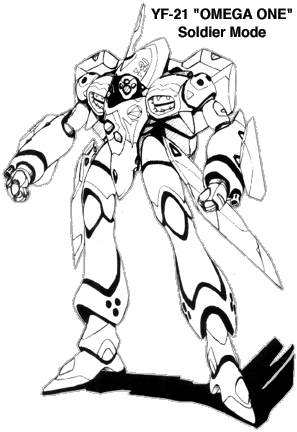 The YF-21 Advanced Variable Fighter (AVF) Prototype was designed
and built in 2039 by General Galaxy as their entry for the Project Super
Nova design contest. Project Super Nova was sponsored by the UN Spacy
to develop the next generation variable fighter that would replace the
aging VF-11
Thunderbolt as the main variable fighter for terran military forces.
The YF-21 was one of two designs selected for the final competition at
the New Edwards Flight Center on planet Eden; the other design being the
YF-19
AVF designed by Yang Neumann of Shinsei Industries.
The YF-21 Advanced Variable Fighter (AVF) Prototype was designed
and built in 2039 by General Galaxy as their entry for the Project Super
Nova design contest. Project Super Nova was sponsored by the UN Spacy
to develop the next generation variable fighter that would replace the
aging VF-11
Thunderbolt as the main variable fighter for terran military forces.
The YF-21 was one of two designs selected for the final competition at
the New Edwards Flight Center on planet Eden; the other design being the
YF-19
AVF designed by Yang Neumann of Shinsei Industries.
Unlike the more traditionally designed YF-19, the YF-21 is literally
a showcase of leading-edge combat technology. Many of fighter's systems
are advanced prototypes, which gives the YF-21 a definite edge in terms
of technology. The fighter also includes a significant amount of Zentraedi
overtechnology in its flight systems, including a revised version of the
inertia vector control system used in the Quimeliquola Quaedlunn-Rau
(Female Combat Armor) battlesuit. The alien technology gives the YF-21
a strong resemblance to Zentraedi battlesuits in soldier mode. The AVF
is also equipped with many cutting-edge human technology systems, including
a revolutionary active stealth system that can absorb radar and other sensor
waves, rendering the fighter invisible to most electromagnetic sensor systems.
However the most advanced systems in the YF-21 AVF are the Brainwave
Control System (BCS) and Brain Direct Imaging (BDI) system. The BCS allows
the pilot to control all functions of the aircraft literally with his thoughts,
while the BDI feeds sensor data directly into the pilot's mind, providing
far more information than traditional HMD (head-mounted display) or HUD
(heads-up display) systems are capable of. When used together, these two
systems allow the pilot to sense and react to situations with the speed
of thought while flying the YF-21. The new systems require some time to
get accustomed to, however, and only certain disciplined pilots are able
to use them to their full potential. In addition, these systems have occasionally
exhibited feedback and control problems with some pilots, including chief
test pilot Guld Boa Bowman.
Two prototypes of the YF-21 were constructed, with the first one having
a conventional flight control system and the second one equipped with the
BCS and BDI systems. YF-21 Prototype No. 2 and its pilot, Chief Bowman,
were invited to the New Edwards Flight Center on planet Eden for final
testing. At first, the YF-21 (codenamed "Omega One") performed flawlessly,
but then began to develop problems due to incompatibilities between Chief
Bowmann and the BCS/BDI systems. Later during a impromptu duel between
the YF-19 and YF-21 the YF-21's right arm was torn off and the YF-19 was
severely damaged by a discharge from its own GU-15 gun pod. This disaster
made the UN Spacy high command nervous, prompting them to halt Project
Super Nova and approve the newly-developed Ghost X-9 Unmanned Fighter
as its replacement for the VF-11.
Unsatisfied by the program's cancellation, Lt. Isamu Dyson and
Yang Neumann stole the YF-19 and its fold booster and made an unauthorized
fold from Eden to Earth. Chief Bowman was ordered to pursue in the YF-21,
which at the time was the only aircraft capable of keeping up with the
hijacked YF-19. The two prototypes engaged in a final combat during the
Macross 30th Anniversary Celebration on Earth, but their grudge
match was interrupted when the newly-awakened AI system for popular rock
star Sharon Apple took control of Earth's computer systems and enslaved
the entire populace via holographic hypnosis. Lt. Dyson and Chief Bowman
overcame their differences and banded together to stop Sharon, and the
YF-21 engaged the prototype Ghost X-9 in combat while the YF-19 confronted
the AI at the SDF-01 Macross. In order to stop the Ghost and give Dyson
more time, Bowman rammed the X-9 with the YF-21, which stopped the renegade
prototype at the cost of his own life. Because of this sacrifice Lt. Dyson
in the YF-19 was able to destroy the Sharon Apple AI, ending the crisis.
After the smoke from the Sharon Apple incident cleared the YF-19 was
declared the winner of Project Super Nova, and was put into production
with the intention of replacing the VF-11 Thunderbolt. However the loss
of the YF-21 did not discourage General Galaxy, and two years later the
company released the VF-22 Sturmvogel II, an advanced combat aircraft
based on the YF-21 prototype. Although the VF-22 did not include the controversial
BDI and BCS control systems of the second YF-21 prototype, it proved to
be an extremely able aircraft and was purchased by the UN Spacy on a limited
basis as a special forces fighter.
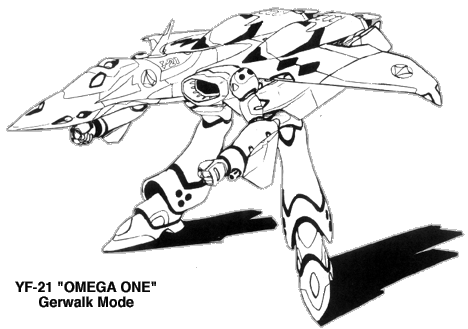
RPG STATS
-
Vehicle Type:
-
YF-21 No. 1 (Initial Prototype; used conventional Variable Fighter flight
control systems)
-
YF-21 No. 2 (Second Prototype; included BCS and BDI control systems. Was
accepted for Project Super Nova contest, callsign "Omega One")
-
Class: Advanced Variable Fighter (Prototype)
Manufacturer: General Galaxy
Crew: One pilot wearing Tactical Life Support System.
MDC BY LOCATION:
Head Pulse Laser 30
(1) Head 120
Hands (2) 50 each
Arms (2) 125 each
Shoulders (2) 100 each
Legs & Thrusters (2) 175 each
(2) Main Body 375
Main Wings (2) 175 each
Tails/Arm Shields (2) 75 each
Stealth Gun Pods (2) 120 each
(3) Pinpoint Barrier Shield 100
Reinforced Pilot Compartment/Escape Pod 150
NOTES:
-
Destroying the head of the YF-21 will knock out the mecha's main sensor
systems, including all of the optics systems (infrared, nightvision, thermal).
Backup sensor systems will provide standard vision for the pilot using
the BDI system. Radar and communications will be unaffected.
-
Depleting the MDC of the main body will destroy the mecha. The pilot and
cockpit section/escape pod will be automatically ejected from the doomed
mecha before it explodes by the YF-21's main computer.
-
The pinpoint barrier shield regenerates at a rate of 50 MDC per round.
Even if completely destroyed the shield will regenerate to full strength
within 2 melee rounds. The shield is usually generated on the right or
left arm of the YF-21.
SPEEDS:
-
RUNNING, SOLDIER CONFIGURATION:
-
120 mph (192 kmph)
-
LEAPING, SOLDIER CONFIGURATION:
-
50 ft (15 m) high or 70 ft (21 m) long without thrusters.
-
FLYING, GERWALK/SOLDIER CONFIGURATION:
-
Mach One (670 mph/1072 kmph) maximum speed limit in an Earth-like atmosphere.
Can also hover in place indefinitely.
-
FLYING, FIGHTER CONFIGURATION:
-
Mach 3.5+ (2345 mph/3572 kmph) max speed at 10,000 meters or less above
sea level. Mach 5.06+ (3390 mph/5085 kmph) max speed at 10,000-30,000 meters
above sea level. Mach 25+ (16,750 mph/25,515 kmph) max speed at 30,000+
meters above sea level, for a maximum of 5 seconds. Cruising speed is usually
Mach 5-6. The YF-21 can vary the configuration of its wings and control
surfaces to provide greater speed or control as the situation requires.
The YF-21 is capable of achieving orbit over an Earth-class planet without
additional rocket assistance. Maximum rate of ascent is 61,500 meters/minute.
G limits are +32.5 to -17.2 Earth gravities.
-
MAX ENGINE THRUST:
-
41,200 kg x2 in an atmosphere, 65,200 kg x2 in space. The maximum thrust
is automatically limited in an atmosphere due to coolant problems with
the optional air intake systems for the engines.
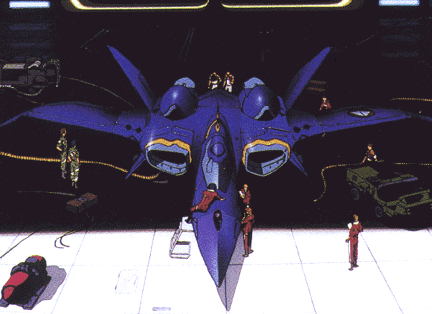
STATISTICAL DATA:
-
HEIGHT:
-
48.70 ft (15.22 m) in soldier configuration.
-
25.98 ft (8.12 m) in gerwalk configuration.
-
12.93 ft (4.04 m) in fighter configuration.
-
WIDTH:
-
22.12 ft (6.91 m) at shoulders in soldier configuration.
-
49.15 ft (15.36 m) in gerwalk or fighter configuration with wings at maximum
extension.
-
LENGTH:
-
13.54 ft (4.23 m) in soldier configuration.
-
45.15 ft (14.11 m) in gerwalk configuration.
-
62.78 ft (19.62 m) in fighter configuration.
-
WEIGHT:
-
9550 kg empty. Maximum takeoff weight in an atmosphere is 39,207 kg, and
maximum weight in space with optional fold booster is 48,305 kg (weights
beyond that exceed theoretical safe limit for fold booster).
-
PHYSICAL STRENGTH:
-
Equal to a P.S. of 60
-
CARGO:
-
Small compartment behind pilot's seat for personal belongings.
-
POWER PLANT:
-
Two 65,200 kg Shinnakasu Industry/Pratt & Whitney/Rolls Royce FF-2450B
thermonuclear turbine engines, designed for dual atmosphere/space use with
optional concealed trapezoidal air intakes for use in an Earth-type atmosphere.
Two 3-dimensional independentent convergent/divergent exhaust are equipped
on the FF-2450B for greater maneuverability and V/STOL performance. In
addition, several Pratt & Whitney HMM-6J high-maneuverability vernier
thrusters are mounted on the wingtips, vertical stabilizers, nose, and
other key locations for added performance. Additional thruster options
include an external fold generator developed for use with Project
Super Nova.
WEAPON SYSTEMS:
-
ERLIKON AAB-7.5 AIR-TO-AIR LASER GUN: The YF-21 mounts a single
laser for use in air combat skirmishes and for defensive purposes. The
laser is mounted on the head of the mecha in soldier mode, and is located
in the forward dorsal section of the main body pointed rearward in fighter
and gerwalk modes. The laser can only fire to the REAR of the fighter in
these modes; it cannot be turned to fire along another arc.
-
PRIMARY PURPOSE: Anti-aircraft
-
SECONDARY PURPOSE: Anti-missile/defensive
-
RANGE: 4000 feet (1200 m)
-
DAMAGE: 1D6 M.D.
-
RATE OF FIRE: The laser can be fired up to 4 times per round. In
addition, the laser can be fired in a continuous beam for cutting purposes.
When used this way, the weapon does 1D6x10 M.D. per round, but cannot be
used against moving targets.
-
PAYLOAD: Effectively Unlimited.
-
MAULER REB-22 LASER GUNS: Two semi-fixed laser gun clusters are
mounted in the arms the YF-21. Like the VF-17
Nightmare the arm lasers have two exit ports (one pointing each direction)
and thus can fire either to the front or the rear of the mecha in any mode.
In fighter mode the lasers can only be aimed along the front or rear arc
of the aircraft (max angle is about 30 degrees in any direction from the
centerline of the fighter) but in gerwalk/soldier they can be aimed in
any direction by moving the mecha's arms.
-
PRIMARY PURPOSE: Anti-mecha
-
SECONDARY PURPOSE: Anti-aircraft
-
RANGE: 4000 feet (1200 m)
-
DAMAGE: 1D4x10 M.D.
-
RATE OF FIRE: The laser can be fired in rapid pulses up to 4 blasts
per round. A rapid fire blast counts as a burst of up to 4 shots.
-
PAYLOAD: Effectively Unlimited.
-
BIFORS BML-02S ALL-ENVIRONMENT RAPID-FIRE MICRO-MISSILE CLUSTERS:
The YF-21 is armed with four internal BML-02S missile launchers that were
built exclusively for the mecha design. The launchers are mounted in the
forward dorsal section of the craft and have exit ports on the wings to
either side of the engine nacelles. Any type of UN Spacy mini-missiles
can be used by the launchers, including the recently developed high-maneuverability
mini-missiles (see YF-19
stats for details). Armor-piercing MMs are standard issue, however.
-
PRIMARY PURPOSE: Assault
-
MISSILE TYPES: Any type of UN Spacy Mini Missile, including
the new High Maneuverability Mini Missiles (HMMMs).
-
RANGE: Varies with missile type, typically 1 miles (1.6 km).
-
DAMAGE: Varies with missile type, typically 1D4x10 M.D.
-
RATE OF FIRE: Volleys of 1-4 missiles (remember that one volley
counts as one attack, regardless of the number of missiles). The rate of
fire of the BML-02S launcher is equal to the pilot's combined number of
attacks.
-
PAYLOAD: 12 missiles per launcher; 48 total.
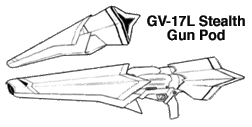
-
HOWARD/GENERAL DYNAMICS GV-17L GUN PODS: For a main external weapon,
the YF-21 contains TWO new stealth gatling gun pods produced by Howard
Industries and General Dynamics. These gun pods are exclusively designed
for the YF-21 and are mounted in specially designed storage bays located
on the underside of the craft in fighter mode, similar to the gatling gun
used by the VF-17 Nightmare. In Gerwalk or Soldier modes the gun pods can
be ejected from their bays and used by one or both of the YF-21's hands.
The gun pods can fire in any mode; they fire out of a special concealed
port when stored away in Fighter mode.
Like the original GU-11 gun pod used by the VF-1 Variable Fighters,
the GV-17L gun pods do NOT use clips of ammo, but instead have a large
internal supply of ammo stored in the barrel of the pod. This allows the
GV-17L to contain a larger supply of ammo and bypasses the need to reload
while in the field. Once exhausted, the gun pods can only be reloaded by
trained technicians at a supply base.
-
PRIMARY PURPOSE: Assault
-
SECONDARY PURPOSE: Anti-mecha
-
RANGE: 4000 feet (1200 m)
-
DAMAGE: Does 4D6 M.D. for a short burst, 1D6x10 M.D. for a long
burst, or 2D6x10 M.D. for a full melee burst.
-
RATE OF FIRE: Equal to the number of combined attacks of the pilot.
-
PAYLOAD: 800 rounds, equal to 80 short bursts, 40 long bursts, or
20 full melee bursts. Once depleted, the gun must be reloaded by a service
technician at a UN Spacy base or starship.
-
WING HARD POINTS: The YF-21 has four fixed hard points (two per
wing) which can be used to hold a variety of different ordinance payloads,
including long, medium, or short range missiles, or even the new medium-range
high-maneuverability (MRHM) missiles. One long range, one MRHM, 3 medium
range, or 5 short range missiles can be mounted per hardpoint. Usually
long range or MRHM missiles are used.
NOTE: Due to the location of the hard points, ALL missiles
must be fired or ejected before the YF-21 can convert into soldier mode.
For this reason the missiles mounted on the hard points are usually fired
within the first few passes of an attack.
-
MEDIUM RANGE HIGH MANEUVERABILITY MISSILES
-
Primary Purpose: Anti-Mecha
-
Secondary Purpose: Surgical Strikes
-
Mega-Damage: 2D6x10 M.D.
-
Rate of Fire: One per hardpoint.
-
Range: 80 miles.
-
Payload: One per hardpoint; 4 maximum.
-
LONG RANGE MISSILES
-
Primary Purpose: Heavy Assault
-
Secondary Purpose: Anti-Spacecraft
-
Missile Types: Any type of standard UN Spacy Long Range Missile
can be used.
-
Range: Varies with missile type.
-
Damage: Varies with missile type.
-
Rate of Fire: One or two.
-
Payload: One per hardpoint; 4 maximum.
-
MEDIUM RANGE MISSILES
-
Primary Purpose: Assault
-
Secondary Purpose: Anti-Mecha
-
Missile Types: Any type of standard UN Spacy Medium Range Missile
can be used.
-
Range: Varies with missile type.
-
Damage: Varies with missile type.
-
Rate of Fire: 1-3 missiles per hardpoint.
-
Payload: Three per hardpoint; up to 12 maximum.
-
SHORT RANGE MISSILES
-
Primary Purpose: Assault
-
Secondary Purpose: Anti-Mecha
-
Missile Types: Any type of standard UN Spacy Short Range Missile
can be used.
-
Range: Varies with missile type.
-
Damage: Varies with missile type.
-
Rate of Fire: 1-5 missiles per hardpoint.
-
Payload: Five per hardpoint; up to 20 maximum.
-
HOWARD PBS-03F PIN-POINT BARRIER SYSTEM: The YF-21 is equipped with
a new mecha-scale pinpoint barrier system for defense. The system can generate
a single pinpoint barrier that can be moved anywhere on the mecha and used
as a shield against incoming attacks. The barrier provides 100 MDC of protection,
and regenerates at a rate of 50 MDC per round when damaged. Even if destroyed
by combined attacks, the shield will regenerate itself within 2 rounds.
In order to use the shield, the pilot must make a successful parry roll
to intercept an incoming attack. Due to the tremendous power requirements
of the system, the head and wing lasers on the YF-21 cannot be used while
the barrier is in operation.
-
Primary Purpose: Defense
-
Protection: 100 MDC total
-
Regeneration Rate: 50 MDC per round.
-
Size: The barrier can be up to 10 ft (3 m) in diameter.
-
Duration: Unlimited.
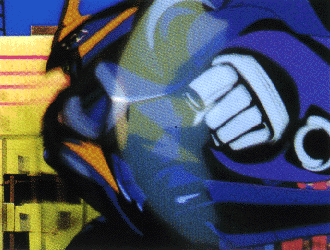
-
HAND TO HAND COMBAT: If necessary, the YF-21 can engage in melee
combat rather than use a weapon. The new AVF is extremely agile and can
execute most typical hand to hand combat moves, such as punches, jump kicks,
leap attacks, rolling with impacts, etc.
DAMAGE:
-
Restrained Punch: 1D6 M.D.
-
Full Strength Punch: 3D6 M.D.
-
"Booster" Punch: 4D6 M.D. (counts as two attacks)
-
Tear or Pry with Hands: 2D4 M.D.
-
Kick: 2D4 M.D.
-
Leap Kick: 3D6 M.D.
-
Body Flip/Throw: 1D6 M.D.
-
Body Block/Tackle: 2D6 M.D.
-
Stomp: 2D6 M.D. (only effective against small objects)
STANDARD EQUIPMENT FOR THE YF-21:
-
ACTIVE STEALTH SYSTEM: The YF-21 is equipped with a revolutionary
stealth system that when activated renders the craft almost invisible to
standard sensors such as radar. Unlike passive stealth systems like those
used by the VF-17 Nightmare or the old USAF F-117, the YF-21's stealth
system is an ACTIVE stealth system that actually bends radar waves around
the mecha rather than reflecting them. When activated, this system gives
the YF-21 a +3 on initiative and a +1 to strike at all times.
NOTE: Since the YF-21's stealth capability is a system and not a
feature of the design, it can be damaged or destroyed. Once the mecha has
lost half of its main body MDC, there is a 50% chance that the stealth
system will fail every time the main body of the craft is hit. Once the
stealth system has failed, it will not work again until repaired at a UN
Spacy base.
-
AUTO-PILOT: The YF-21 is equipped with a computerized auto-pilot,
allowing the pilot to relax or even sleep during long voyages. The auto-
pilot can be programmed with a single destination or a complex flight plan
involving multiple speeds, directions, and destinations. The onboard computer
will alert the pilot when the fighter is near its destination, and can
also be set to automatically signal when sensors detect objects near the
mecha. The auto-pilot was designed with long intra-system space journeys
in mind.
-
BRAIN CONTROL SYSTEM (BCS): This revolutionary
and experimental system is one of the most unique abilities of the YF-21.
The BCS system allows a disciplined pilot to link his mind with the onboard
computer of the mecha, and issue control commands to it at the speed of
thought. This allows the YF-21 to move with human-like reflexes and respond
with human- like speed. Feedback for the system is transmitted back to
the pilot using the brain-direct imaging (BDI) system (see below), providing
an interactive control loop that literally makes the mecha a part of the
pilot.
The disadvantage of the system is that it requires a fair amount
of concentration to use. If the pilot of the YF-21 is suddenly startled
or disturbed, he may lose control of the mecha and be unable to regain
it until he calms himself down. It requires a fairly dramatic event to
startle the pilot sufficiently, such as being physically wounded, seeing
a comrade killed in front of him, or (in Chief Bowman's case) being suddenly
confronted with a despised enemy and suffering a flashback. If startled,
the pilot must roll under his M.E. attribute on a 1D20 to keep control
of the plane. If he fails, the BCS fails and the YF-21 will freeze. In
order to regain control of the BCS, the pilot must calm himself sufficiently,
which requires another successful roll under his M.E. attribute. NOTE:
the GM may impose penalties to the above rolls if the pilot is going through
a VERY traumatic experience while flying the YF-21.
Another disadvantage of the BCS is that when uncalibrated to a specific
user, the system has a tendency to pick up stray thoughts from the pilot
and act upon them without his permission. A particularly nasty example
of this happened during the Project Super Nova tests when Chief Bowman
imagined slamming Pilot Isamu Dyson's VF-11 into the ground, and the BCS
picked up and acted on that idle thought. When properly calibrated there
is no danger of this occuring, but when an uncalibrated system is being
used by a pilot during game play, the GM should roll against the player's
M.E. whenever the player makes an idle remark about what he would like
to do with the YF-21 (even if he was just mentioning it in jest). If the
GM rolls above the player's M.E., the YF-21 will do EXACTLY what the player
mentioned, regardless of the consequences.
The cockpit of the YF-21 is equipped with a backup set of standard aircraft
controls in case the pilot looses control of the BCS and cannot re-establish
contact. Initial versions of the BCS were calibrated specifically for human
brain waves, which led to problems when the system was used by non-human
pilots such as Chief Bowmann. Zentraedi or other alien pilots using a non-
calibrated BCS system receive a +5 penalty to their rolls to keep control
of the system.
-
BRAIN DIRECT IMAGING (BDI) SYSTEM: This prototype
system, along with the BCS, allows the pilot of the YF-21 to essentially
control the mecha with his thoughts. The BDI system is extremely important
to thought control, as it provides the pilot with visual and tactile feedback
from the mecha, including things such as balance and force feedback. The
BDI essentially makes HUD (heads-up display) and HMD (head mounted display)
technology obsolete since instead of overlaying a display with computer-
generated graphics the pilot can receive direct sensory input with computer
analysis and highlights directly into his brain. In game terms, this provides
the pilot of the YF-21 with a +20% bonus to any skill rolls made to control
the mecha, a +2 bonus to dodge and a +1 bonus to strike.
The BDI system does have a drawback, however. Human (and Zentraedi)
brains were not designed to accept this type of intense input, and use
of the BDI system can lead to stress, fatigue, and headaches. Frequent
use of the BDI can even lead to stress-induced tramua-like symptoms manestifying
themselves such as sleeplessness, frequent migraines, shaky hands, cold
sweats, and short tempers/emotional problems. After each week of frequent
use of the BDI system, the pilot must roll under his P.E. stat or the character
will begin to exhibit one of the above symptoms (GMs choice). The base
medical officer can prescribe drugs to surpress the symptoms, but the only
way for the pilot to be cured is to stop using the BDI system. It is not
known what long-term use of the BDI system without breaks will do to a
pilot.
NOTE: Although the cockpit of the YF-21 does NOT contain any
windows except a top-mounted radome (the BDI makes windows unnecessary,
theoretically), a backup display monitor is included for the pilot in the
event of BDI system failure. This monitor, while acceptable as an emergency
backup, is not well designed for a combat fighter, and being forced to
rely solely on it imposes a -3 penalty to hit and dodge rolls by the pilot.
-
COMBAT COMPUTER: The YF-21 is equipped with a combat computer that
can store and analyze data during combat with hostile forces. Data collected
by the combat computer can be viewed by the pilot either on standard HUD
displays mounted on the cockpit viewports, or using the new BDI system
(see above). This allows the computer to display large amounts of data
to the pilot and even highlight enemies and missile attacks with overlaid
graphics. The combat computer tracks and identifies specific enemy targets,
and has a database of over 10,000 images stored in memory. The computer
can identify and track up to 250 targets simultaneously.
-
DETATCHABLE LIMBS: The arms and legs of the YF-21 are detatchable,
so that in the event one or more of the limbs of the mecha are damaged
they can be ejected from the main body so as to avoid creating atmospheric
drag or preventing transformation. The YF-21's arms and legs don't contain
any critical systems so the AVF's performance will be unaffected if they
are jettisoned. However, the YF-21 will not be able to hold its GV-17L
gun pod in gerwalk or soldier mode if both arms are ejected.
-
ESCAPE POD: The entire reinforced cockpit of the YF-21 is a detachable
escape pod that can be jettisoned when the mecha is destroyed. The ejected
cockpit does not contain thrusters, but does contain a powerful locator
beacon and an integrated life support system that can support the pilot
for up to 24 hours after ejection. The pod is also equipped with parachutes
in case of ejection in an atmosphere. The combat computer is programmed
to automatically eject the escape pod if the mecha is destroyed (main body
MDC reduced to 0), but this can be overridden if the pilot is feeling suicidal
for some reason.
-
EXTERNAL AUDIO PICKUP: Range: 300 ft (91.5 m). A sound amplification
system that can pick up normal conversation up to 300 feet away.
-
HEAT AND RADIATION SHIELDS: Special shielding prevents the penetration
of life threatening head and radiation. A radiation detection and alarm
system are linked with the shields and will sound an alarm if there is
a rupture in the shields and what the levels of radiation are.
-
HOMING SIGNAL: The escape pod of the YF-21 is equipped with a homing
device that enables rescue teams to locate a disabled craft or ejected
life pod. The range of the signal is 400 miles (640 km). Most UN Spacy
ships and variable fighters can locate and track homing signals, and the
onboard computers will automatically notify their pilots if such a signal
is detected.
-
LASER TARGETING SYSTEM: Range: 100 miles (160 km). Used for increased
accuracy in the striking of enemy targets and is partly responsible for
the mecha's strike bonus.
-
LOUDSPEAKER: A loudspeaker system is built into the craft, which
can be used to amplify the pilot's voice up to 90 decibels.
-
OPTICS: WIDE-SPECTRUM SENSORS: Range: 2000 feet (610 m). This new
active/passive optical system is able to view and project light from any
portion of the visible and invisible spectrum, from infrared to ultraviolet
and everything in between. Among other things, this system allows the pilot
to see in the dark or through smoke using infrared, through water or fog
using ultraviolet, and even detect heat emissions from concealed targets.
The sensors can use either an active or passive scanning mode. In active
mode, the YF-21 actually projects a beam of light (visible or invisible)
and views the reflection off objects. In passive mode, the sensors simply
receive data without emitting light. Active mode provides more detailed
pictures, but passive mode reduces the risk of detection by IR or UV sensors.
The system provides the pilot with a bonus of +10% when tracking or trying
to detect an ambush. Results of the scans can be viewed either on HUD displays
or using the BDI system.
-
RADAR: 200 mile (321 km) range.
-
RADIO/VIDEO COMMUNICATION: Long range, directional communications
system with satellite relay capabilities. Range: 600 miles (960 km) or
can be boosted indefinitely via satellite relay.
-
SELF-DESTRUCT: To prevent capture of a Variable Fighter fighter
by the enemy, the pilot can activate the YF-21's self-destruct system,
which will cause the fighter to explode after a delay of up to 60 minutes
(time is set by the pilot). The explosive damage is contained within a
20 foot (6 m) area and inflicts 1D6x10 M.D. to everything within the radius
of the explosion. All internal systems are obliterated. The escape pod
will be automatically ejected prior to the explosion unless the pilot overrides
the ejection sequence.
-
STANDARD SURVIVAL KIT: All UN Spacy Variable Fighters come equipped
with a portable survival kit. Inside the small reinforced box is a medium-sized
flashlight, two hand flares, one rocket flare, a compass, infrared distancing
binoculars, a small mirror, a pocket knife, dehydrated and concentrated
food (can be stretched into a five day supply for one person) and basic
first aid items (aspirin, bandages, disinfectants, etc.)
-
TACTICAL LIFE SUPPORT SYSTEM: The YF-21's cockpit is pressurized,
and also provides additional air feeds to the pilot's flight suit that
provides him with pressurized breathing. The UN Spacy flight suit also
contains an upper and lower g-suit that promotes blood circulation even
during high-g turns, thus decreasing the possibility of pilot's blacking
out in combat.
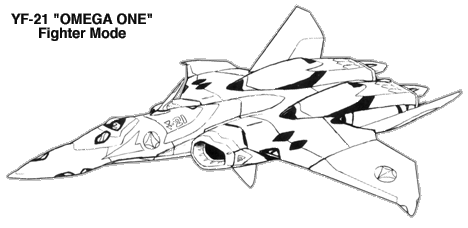
COMBAT BONUSES FOR YF-21 FIGHTER TRAINING:
NOTE: Due to the prototype nature of the YF-21, it is
highly recommended that no player be allowed to start the game with YF-21
BDI/BCS combat training (unless the GM is running a very unusual campaign).
Untrained pilots should get bonuses equal to Basic Variable Fighter
Combat Training when piloting the YF-21, and military pilots with no
prior YF-21 experience should get full bonuses from Advanced VF-11 Variable
Fighter Combat Training. However, this only applies to players trying
to fly the YF-21 with conventional controls; characters trying to fly a
YF-21 using the BDI/BCS systems for the first time only get Basic Variable
Fighter Combat Training bonuses regardless of their experience!
The BDI/BCS systems take immense amounts of training and discipline to
be used at maximum efficiency.
ADVANCED YF-21 BDI/BCS AVF COMBAT TRAINING
-
Advanced training for pilots specializing in the YF-21 and
trained to take full advantage of the Brain Control System and Brain Direct
Imaging systems of the prototype.
-
4 attacks per melee (plus those of the pilot).
-
Add one additional action/attack at levels two, five, seven, and ten.
-
+2 on initiative (+5 when using Active Stealth System)
-
+3 to strike (+4 when using Active Stealth System)
-
+4 to parry
-
+3 to dodge in solder mode, +5 in gerwalk, +7 in jet mode.
-
When using BDI/BCS, add +2 to dodge and +1 to strike to above bonuses.
-
+3 to roll with a punch or fall with an impact, reducing damage by half.
-
+4 to leap dodge. A leap dodge is an automatic dodge which causes no loss
of attacks per melee. The new generation AVFs are so maneuverable that
the pilot can dodge an attack while moving to counterattack an enemy.
-
Critical strike same as pilot's hand-to-hand.
-
Body block/tackle/ram - 2D4 M.D. plus a 50% chance of knocking an opponent
down, causing him to loose initiative and one attack that melee round.

 The YF-21 Advanced Variable Fighter (AVF) Prototype was designed
and built in 2039 by General Galaxy as their entry for the Project Super
Nova design contest. Project Super Nova was sponsored by the UN Spacy
to develop the next generation variable fighter that would replace the
aging VF-11
Thunderbolt as the main variable fighter for terran military forces.
The YF-21 was one of two designs selected for the final competition at
the New Edwards Flight Center on planet Eden; the other design being the
YF-19
AVF designed by Yang Neumann of Shinsei Industries.
The YF-21 Advanced Variable Fighter (AVF) Prototype was designed
and built in 2039 by General Galaxy as their entry for the Project Super
Nova design contest. Project Super Nova was sponsored by the UN Spacy
to develop the next generation variable fighter that would replace the
aging VF-11
Thunderbolt as the main variable fighter for terran military forces.
The YF-21 was one of two designs selected for the final competition at
the New Edwards Flight Center on planet Eden; the other design being the
YF-19
AVF designed by Yang Neumann of Shinsei Industries.




